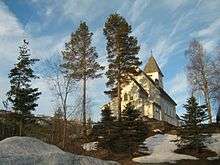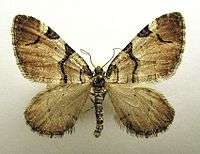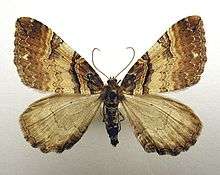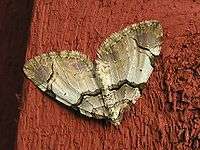Pål Olson Grøt
Pål Olson Grøt (1813–1906) was a Norwegian Rosemaling painter who belonged to the most important Rosemaling painters in Hol, where he was born in 1813, and lived until he moved to the village of Hovet, Buskerud in 1852, where he died in 1906.
Genealogy
The genealogy, the family history of Pål Olson Grøt, small parts of it, are registered in several books and websites. However, there are differences in names, the way of writing the names, and differences in birth dates. In the book "Rosemåling i Hallingdal",[1] the author Nils Ellingsgard writes that Grøt painted himself on a wooden coffer, and named himself Paul Olsen Neeraal, born on December 15, 1813.
According to the church book however, Nils Ellingsgard writes in his book, he was baptized on December 13, 1812. The digitalised "Hol kirkebog" (church book of Hol) starts at January 1, 1900, and cannot offer more information about the date of birth, since it was in 1852. The date of his death, in 1906, is not registered in the Hol Kirkebog,[2] probably because Pål Olson Grøt lived in Hovet, Buskerud. Hovet got its own graveyard[3] in 1890, located at what was then named the Håkonsethaugen, probably the same place as where the church has been built in 1910.
 The church of Hovet
The church of Hovet
This church is on a "haugen", a tiny hill, very near to the Håkonsæt fjellvilla. In MyHeritage Pål Olson Grøt is named Paul Olsen Grøtt,[4] born 13 December 1813, dead 1 February 1906. The Norwegian page about Pål Olson Grøt follows the church book archives.
The name Nerolshaugen
According to the book, Pål Grøt was born and raised at Nerolshaugen. Neeraal pronounced in Norwegian sounds the same as the word Nerol. In the village Hol is a street named Nerolsvegen,[5] what means literally the "vegen" (street) of Nerol. Probably Nerolsvegen was named earlier Nerolshaugen. The word Haugen is derived from the old Norwegian "haug", a word for a little hill, but also for farm homesteads. The street "Nerolsvegen" is indeed on a "haugen", The word Nerolshaugen means literally the haugen of Nerol. The word Nerol is also in the family name of Pål Olson Grøt's father: Ola Eirikson Nerol.[4] It was a habit in that time to use the place where one lived next to the family name.
The name Grøt
This was the reason that Pål Olson Nerolshaugen changed his name into Pål Olson Grøt when he moved to Hovet, and bought a farm on land with the name Grøt,[6] in 1852. The true family name is therefore Olson. The farm where Pål Olson Grøt also lived still belongs to the family. It is unclear why there has been added an extra t in the name Grøt. In the family tree[4] one can see several family members with different written names: Grøt and Grøtt.
The name Olson
Since Pål Olson Grøt's father's first name was Ola, "Ola's son" has obviously been merged into "Ol's sønn", and finally into Olsen, which sounds the same as Ol's sønn. Pål Olson Grøt wrote his own name as Paul Olsen, with e. Others, like Nils Ellingsgard, wrote the name as Pål Olson, with o. On the MyHeritage page the name is written as Paul Olsen Grøtt, with e. Daughters of Ola were named Olsdatter. Datter is Norwegian for daughter.
The name Pål
In the My Heritage page[4] Pål Olson Grøt's first name has been changed into the American name Paul. Nils Ellingsgard mentions in his book that several children of Pål Olson Grøt moved to USA.
His life in Hovet
In 1852 Pål Olson Nerolshaugen moved to Hovet, and started living on a farm, built on a land with the name Grøt.[6] From that time on he named himself Pål Olson Grøt. On April 11, 1860, when he was 47 years old, and 8 years after he moved to Hovet, he married with Marita Iversdatter Kleppo, born in Hovet, on November 15, 1839. They had six children. Two sons and one daughter emigrated to the US. Pål Olson Grøt died in 1906, in Hovet, and is probably buried on the graveyard[3] of Hovet, then named Håkonsethaugen. His wife Marita Iversdatter Kleppo[7] died in 1920.
 Farm in Hovet, Hallingdal, where Pål Olson Grøt lived
Farm in Hovet, Hallingdal, where Pål Olson Grøt lived Farm in Hovet, Hallingdal, where Pål Olson Grøt lived
Farm in Hovet, Hallingdal, where Pål Olson Grøt lived Farm in Hovet, Hallingdal, where Pål Olson Grøt lived
Farm in Hovet, Hallingdal, where Pål Olson Grøt lived
Rosemaling
Rosemaling means «rose painting», and is a traditional Norwegian decorative painting style. Rosemaling in Norway originated in the low-land areas of eastern Norway particularly in Telemark and Hallingdal, but also in Numedal and Setesdal and in other valleys in Vest-Agder, Hordaland, Sogn og Fjordane and Rogaland. It came into existence around 1750, when Baroque and Rococo, artistic styles of the upper class, were introduced into Norway's rural culture. Pål Olson Grøt lived in the traditional district of Hallingdal. Characteristic for the Hallingdal[8] style are baroque scrolls and acanthus leaves wrap around a central flower. The designs are symmetrical, using opaque color and not generally shaded. Backgrounds are red, black-green, dark green, and a lighter blue-green.
Pål Grøt was a pupil of Nils Bæra[9] in Ål and became one of the most important Rosemåling painters in Hol.[10] His style has many common features with the style of the Torstein Sand cohabitation. Torstein Sand was also a pupil of Nils Bæra. Both became important examples for contemporary and later Rosemåling painters in Hol. Pål Grøt has painted many beer buns with great variety and imagination. His wooden box painting usually has a basic theme and the middle motifs are often animal figures or houses.
From the early 1830s rosemåling was Pål Olson Grøt's main activity, but he was also a skilled carpenter and skilled in wood carving. As a painter, he had his most productive period in the 1840s and 50s.
 Trøys. A trøys is a wooden can that was used primarily for beer, but there is also evidence that they were used for milk. Trøyser can have the shape of bowls, bowls or troughs with tut or beak to pour on one side, and often one ear or handle on the other. The word trøys is related to the Old Norse word "trog" and the English "through".
Trøys. A trøys is a wooden can that was used primarily for beer, but there is also evidence that they were used for milk. Trøyser can have the shape of bowls, bowls or troughs with tut or beak to pour on one side, and often one ear or handle on the other. The word trøys is related to the Old Norse word "trog" and the English "through". Wooden coffer
Wooden coffer
Rosemålere
The Hallingdal Rosemaling style, used also by Pål Olson Grøt, is symmetrical, the best to be explained by watching a butterfly, with a center and a left and right side that mirror each other. It might be, maybe not, a coïncidence that in the Norwegian language also the word Rosemålere exists, the name of a special butterfly. The name Rosemåler sounds very much familiar with Rosemaler. A rosemaler is a rosemåling painter. A Rosemåler is a butterfly.
 Anticlea derivata mounted, in Norwegian: Rosemåler
Anticlea derivata mounted, in Norwegian: Rosemåler- Anticlea derivata, SLU; belonging to the category Rosemålere
 Earophila badiata, "Brun rosemåler", belonging to the category Rosemålere
Earophila badiata, "Brun rosemåler", belonging to the category Rosemålere Anticlea derivata, "Fiolett rosemåler", belonging to the category Rosemålere
Anticlea derivata, "Fiolett rosemåler", belonging to the category Rosemålere
Museums
Pål Grøt is represented in the collections at Hol Bygdemuseum, Hallingdal Museum, Drammen Museum and Norwegian Folk Museum.
Literature
References
- ↑ "Hattfjelldal folkebibliotek : Rosemåling i Hallingdal". biblioteket.hattfjelldal-kommune.no. Retrieved 2017-10-12.
- ↑ "Kirkebøker: SAKO, Hol kirkebøker, G/Ga/L0001: Klokkerbok nr. I 1, 1900-1919, s. 1 - Skanna arkiver - Arkivverket". media.digitalarkivet.no. Retrieved 2017-10-12.
- 1 2 "Hovet kapell". Norges Kirker. Retrieved 2017-10-12.
- 1 2 3 4 "Paul Olsen Grøtt - Nettsiden til familien Grøtt Tvedt". MyHeritage. Retrieved 2017-10-12.
- ↑ "Kommunekart – Hol, map". kommunekart.com. Retrieved 2017-10-12.
- 1 2 "Kommunekart – Grøt, Hovet". kommunekart.com. Retrieved 2017-10-12.
- ↑ "Marita Iversdatter Grøtt (born Kleppo) - Nettsiden til familien Grøtt Tvedt". MyHeritage. Retrieved 2017-10-12.
- ↑ "Hallingdal style". rosemaling.org. Retrieved 2017-10-12.
- ↑ "Nils Bæra – Norsk biografisk leksikon". nbl.snl.no. Retrieved 2017-10-12.
- ↑ Nils, Ellingsgard (July 3, 2013). "Pål Olson Grøt – Norsk kunstnerleksikon". NORSK KUNSTNERLEKSIKON. SNL association. Retrieved 17 October 2017.
External links
- Digitalt museum: Pål Olson Grøt / Trøys